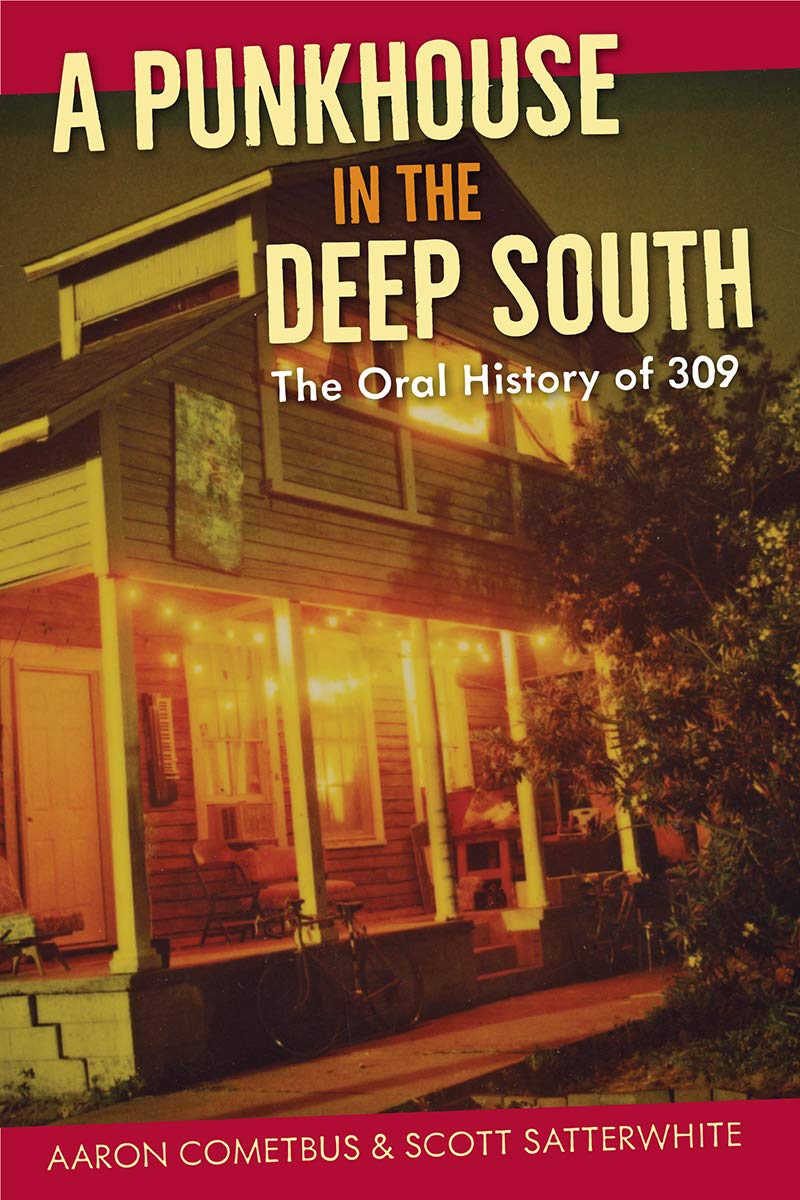|
Review by A. Iwasa A Punk House in the Deep South: The Oral History of 309, the latest book by Aaron Cometbus and Scott Satterwhite, stands not just as an epic history of a punk house, but also a model of how other punx can tell the stories of their scenes. Read the full review below. "A Punk House in the Deep South" is the first book-length, non-fiction treatment of punk house dwelling, and its strength is in its process as oral history of participants, bringing out what I would consider the obvious such as listening to and making punk rock, and putting on shows, but also painting, making 'zines, friendly feuds with other punk houses, participation in other collective forms such as a community center, and demonstrations for choice in a town where there had been anti-abortion bombings. An oral history of 309, one of the United States' oldest punk houses, which was founded by members of This Bike is a Pipe Bomb, is possibly the best choice out there for such ground breaking work. In the introduction, punk houses are defined in the context of both punk rock and different forms of collective living. The book starts by describing Pensacola, Florida, both as the home of 309 and as a city founded by a conquistador in 1559, before zeroing in on how the book began as a project. The introduction describes punk as "a pyramid scheme, the payoff being membership in an exclusive club that shares resources," etc. But off the bat the first interviewee Skott Cowgill is describing all the good aspects such as sharing food not just with friends but by setting up a cheap cafe in the house, the Spare Change Cafe, and serving Food Not Bombs, which frequently was a larger group than those who showed up to eat. Along these lines, they were able to similarly mobilize people to protest the Klan and other acts as such. But Cowgill admits once all the local outlets for painting had been exhausted, he had to move on, which shows an essential mixed blessing-curse of such an environment. You can learn, grow, and share so much, but will probably, eventually, hit a wall, ceiling or cliff forcing you to either leave or be stifled. The important thing here is Cowgill acknowledging how great 309 was as a step. Each interview has a pull quote as a title, which is a nice touch. "We were used to living in squalor," and, "To say it was a shitty old house is an understatement," are a couple of my favorites. Different forms of collective living all seem to have their pros and cons, but people who make it out to be The Revolution in and of itself or an inherently Lord of the Flies-Animal Farm cultish mashup nightmare are laughable at best or dishonest at worst. Sure, communal living will have to be part of any radical change by default of how movements of people can be coordinated, and when things go wrong they can be purely toxic. But punk house dwelling is possibly the most underrated and unacknowledged form of collective life, at least compared to its ancestors in religious compounds, socialist colonies, and hippie communes. The first three interviewees had parents in the FBI, Airforce, and Navy respectively — not a shock since I've known plenty of rebellious military brats and children of cops. But I was excited off the bat by Gabe Smith's interview for bringing tattooing into the equation, but far more importantly, Smith's father performed at the Grand Ole Opry and was a civil rights worker. Smith stresses this is protopunk, and I'm fascinated by the stories of people like Smith who are encouraged to, instead of having to, rebel to not judge people and be free to experiment. Dating the scene, Smith talks about a show hotline on an answering machine at Sluggo's, a venue started by the second interviewee, This Bike is a Pipe Bomb's Terry Johnson. Adding even more historical context, Smith also talks about Pensacola as a logistics hub, and 309 originally being "a flophouse for the railroad." Instead of becoming a museum of punk rock, Smith thinks 309 should be at least mostly about trains or for the homeless. As a near lifelong rail fan who has spent years on both sides of the soup line, I love the idea of 309 being a punk rock railroad homeless shelter. What could be more punk? Or at least crust. It's not even until page 59 during the sixth interview that the band I had been a longtime fan of was mentioned, La Armada, in direct relation to the scene, but everything is relatable both good and bad. It's solid reading. Sort of similarly, it isn't until Aaron Cometbus's interview where gaming is mentioned. The seventh interviewee, Cometbus more that anyone else tries to bring it all together, talking about everything punk beyond the music from vandalism to their own board game, Suckcesspool, and from Vietnamese language classes at their bookstore to Anarchist soccer. All of the things! Six interviews follow, every one of them bringing unique perspectives to the account. This book stands not just as an epic history of a punk house, but also a model of how other punx can tell the stories of their scenes, and how everyone can create or improve their own. Written by Aaron Cometbus and Scott Satterwhite $19.95, 143 pages University Press of Florida 2046 NE Waldo Rd. Suite 2100 Gainesville, FL 32609 Available through Microcosm Publishing or your local bookstore!
0 Comments
Leave a Reply. |
Categories
All
Blog Archives
July 2024
|


 RSS Feed
RSS Feed